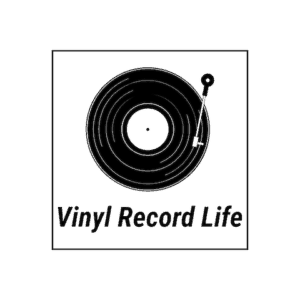If you’ve managed to damage one of your prized possessions or you’ve found out after purchasing a second-hand record that it’s flawed in some way, then you’re probably wondering if there’s any way to salvage it.
Depending on the type of damage, and also the gravity, there may be a way to recover it, at least partially.
There are many ways in which a record can get damaged, but the most common is scratching.
To fix a scratched record, first clean the record to remove any surface dirt. Once clean, locate the scratch and using a USB microscope to see the grooves, gently retrace the grooves with a very fine toothpick or needle. Clean the record surface again and then listen back to the record.
In this article we’ll detail the specific steps you can take to repair a scratched record, as well as looking at the various other ways a record can become damaged, and where there are fixes for these problems we look at what they are.
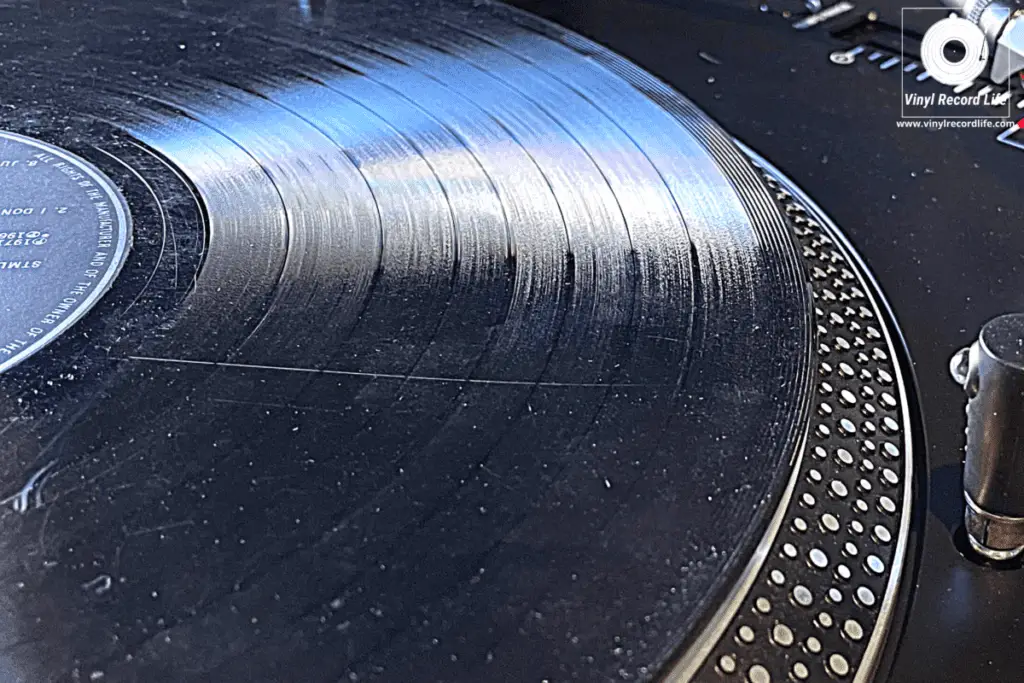
Laying the Foundations: Busting Some Myths and Being Sensible
There is a lot of information online about how to fix a damaged or broken record. Some of it is very good and highly informative, but a lot of it is misleading and/or plain wrong.
The first thing to establish is that it isn’t always possible to fix a damaged or broken record. A lot of the time, a record will be damaged beyond repair, even if the damage appears to be minor or superficial.
It’s always worth keeping this in mind, especially when you encounter advice that states you can use sandpaper, glue and various other materials to fix records.
The impact using these kinds of products can have isn’t just on your records which, while already damaged in the first place, could come off a whole lot worse after being sandpapered, glued or mistreated in any number of ways.
It’s the impact this kind of approach can have on your equipment that is especially problematic. Specifically, the stylus of your turntable will be put at risk if you start playing records that have had their surface rubbed or coated with any substance that isn’t a specialized record-cleaning solution.
In this article we’ll cover the frequent types of damage you’re likely to encounter on a vinyl record, and we’ll look at sensible solutions that offer the most realistic possibility for helping you to recover your record and keep using it.
Types of Damage You’re Likely to Encounter on a Vinyl Record
These are the most common kinds of problems that affect records.
Record Scratches
A scratch, or scratches, are the curse of most record collectors and nearly every record I own has at least a few micro scratches.
The material with which records are made, the sheer expanse of the playing surface, and the many environmental factors (dirt, dust, just to name a couple) that a record faces all add up to make it almost inevitable that a record will get scratched in some way.
Often, a record has micro scratches that have no impact at all on the sound quality or on the stylus of your record player, but there are serious scratches too, ones that will greatly impact the sound and also your playing equipment.
Because scratches are the most common kind of damage, we’ll focus on this area further down the article.
Record Warping
A warp is another fairly regular occurrence with records, and it can easily happen due to a number of factors.
Heat, not ideal storage conditions, weight or pressure on the records and a few other things can lead to a warped record, which is simply when a record gets misshapen.
You can read more on warped records, the causes and solutions here.
Cracks in a Record
A crack in a record is really bad news, and is often caused by the record being dropped or poorly stored, and subsequently having pressure applied in a way that will cause damage or cracking.
Vinyl records are delicate but they are also robust, however like everything they have their limits.
To be honest, I’ve only ever experienced a cracked record twice. If you’re careful with your records then a crack is something you’re likely to encounter only a handful of times, if at all.
Moldy Records
Mold and humidity damage on a record will only happen if records are stored in conditions that don’t meet the most basic of good practice record storage requirements.
A dry environment where the temperature and humidity are well regulated will help prevent mold damage.
Mold on a record will slowly destroy the disc, but what’s worse and more immediate is the damage it’ll potentially cause to the stylus on your turntable.
Superficial Damage to Record Covers
This isn’t one that directly affects the sound quality of the record or your ability to enjoy the music, but damage to record covers can lead to other problems further down the line.
Covers protect your records, so they need to be well taken care of. An outer jacket which is damaged and falling apart won’t do a great job of keeping your record safe, and if you’re using an inner sleeve that’s tatty and old, that will also have a detrimental effect.
Record jackets should at least be properly sealed around all but one side, to ensure the record stays in the jacket.
Sometimes it’s impossible to ensure they don’t get worn, especially if you’ve bought the record second hand, but keeping them in good condition is important. The same for inner sleeves and outer sleeves.
Can Vinyl Records That Have Been Damaged Be Repaired?
Not all records that have been damaged can be repaired. Warped records can often be flattened, and some scratches can be partially repaired, while jackets can be taped. But there is some damage to records that is irreparable.
Essentially, the possibility of repair depends on the type of damage and the extent of it. Often, an attempt at repair should be seen as a bit of an optimistic last resort, because there are never any guarantees and you could end up doing more damage to the record and your turntable stylus.
Here, we’ll now look at how each type of damage listed above can be tackled.
But before you ever attempt any kind of repair on a record, you should always first give it a good clean, to help minimize the risk of causing any further damage.
You may well find that what you thought you’d identified as damage on your record because of a sound defect was in fact embedded dirt, and that a good clean can solve the problem.
Repairing a Scratched Record: Step by Step Guide
Can you really fix a scratched record? Not always, and never completely, but it is possible to minimize the effects of scratches and the damage they can cause to your stylus.
Step #1: Prepare the Record
After you’ve cleaned your record, place it on top of a lint-free cloth that’s been laid down on a hard, flat surface such as a table top.
Step #2: Isolate the Scratch
Get some good light concentrated onto the record surface, and identify where the scratch is that you want to work on.
Sometimes, the scratch is staring right at you, but other times you may have heard a skip on your record while it’s playing but now that you’re looking at its surface you can’t see the offending damage.
This may be because it’s a micro scratch, and these are usually a lot harder to locate. However, if you’ve watched the spinning record while listening to it, you may have been able to work out where the scratch that’s causing the issue is.
Step #3: Use a Wooden Toothpick to “Retrace” the Grooves
Once you’ve found the scratch, take a wooden toothpick, a magnifying glass or a USB microscope (or even a proper microscope, if you have one to hand!), and gently place the top of the toothpick into the grooves where the scratch is.
Very gently, rock the toothpick side-to-side, and edge it along the groove. This action is an attempt to delicately retrace the groove, and help clear the path for the stylus to be able to pass through without being forced to skip or jump out of the groove.
Once finished, give the record another good clean before playing it.
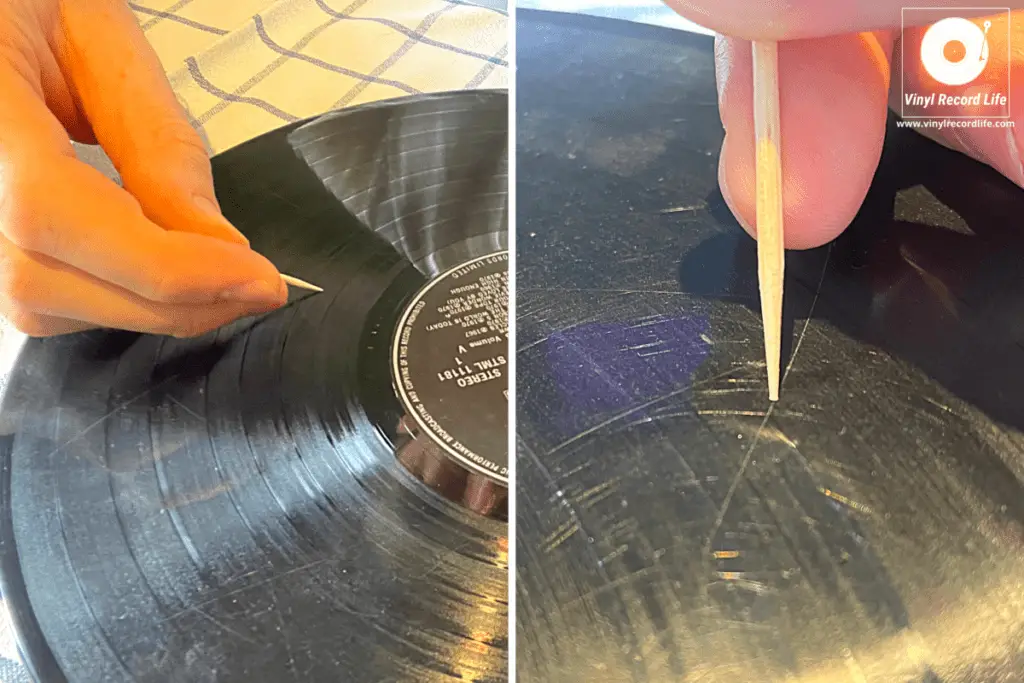
Repairing a Warped Record: How To Straighten Out Records That Have Become Misshapen
Fully recovering a warped record is much easier and far more likely than being able to fix a scratched record.
Step #1: Lay the Record Flat on a Clean, Lint-free Cloth
A microfiber cloth will work best here, so place your freshly cleaned record on top of one cloth, and then place another cloth on top of it.
The cloths should completely cover the record, protecting its entire playing surface on both sides.
Step #2: Transfer the Record Onto a Heavy and Flat Object
Find something big, flat and heavy – but not too heavy – and which has a larger surface area than the record. A big book is my preferred object here.
The record should sit on top of the book (or whatever you’re using) and not overlap any of its edges.
Then place a second similarly large, flat and heavy object on top of the record, so that you have a multi-layered sandwich of heavy object-protective cloth-warped record-protective cloth-heavy object.
I can’t stress enough how important it is to not have something that’s too heavy. The weight should be such that it applies enough pressure to the record to gently and slowly flatten it, but not apply too much pressure.
Trying to Repair a Cracked Record
There are a lot of methods suggested online for fixing a crack in a record, but my honest opinion is that if a record’s cracked, you just have to accept it’s a goner.
Employing some of the many methods spouted online could cause real damage to your stylus.
On top of that, it’s not only extremely difficult but usually impossible to satisfactorily repair a crack in a record. Let it go!
How To Address Mold and Humidity Damage on a Record
If you’ve got a record that’s been affected by mold due to being stored in a humid or wet environment, then a deep clean is the best way to recover the record as much as possible.
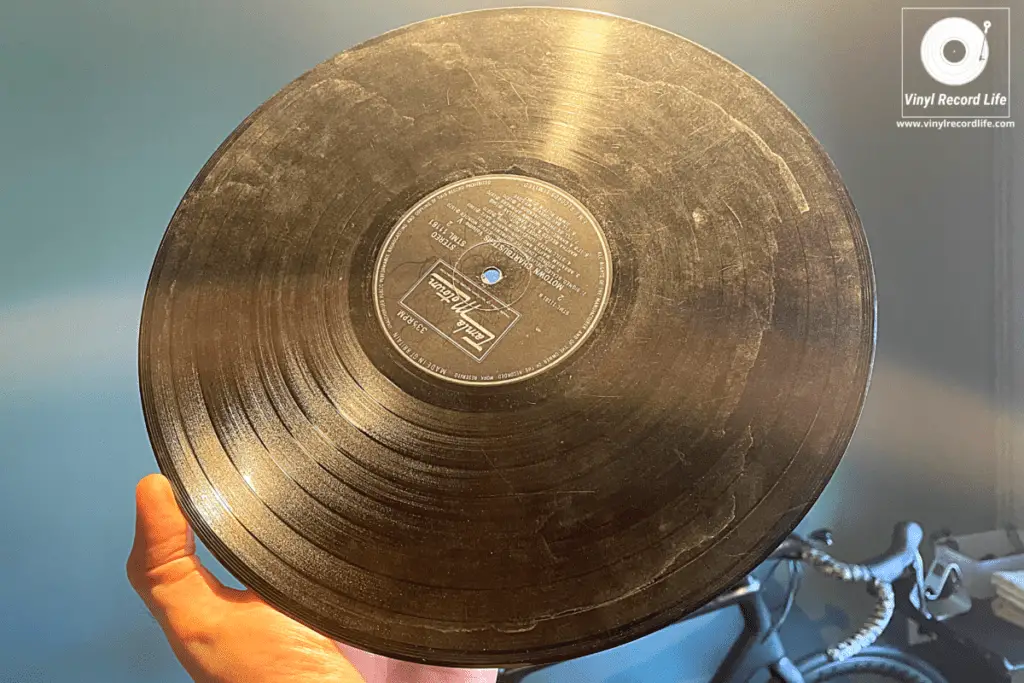
Check out our how to safely clean a record guide, in which we take you through the steps for giving your record a really good deep clean.
Once you’ve cleaned a record that’s been hit by mold, it’s important to give it a new inner sleeve, as the old inner sleeve has more than likely contributed to the condition of the record. Often, old paper inner sleeves on records have deteriorated to such an extent that they compound any moldy residue.
These anti-static inner sleeves (link opens in Amazon) are the ones I highly recommend – they work great and will help keep your freshly cleaned and now mold-free records just that.
If it’s the record’s jacket that’s gathered mold, you can try and clean it with some cleaning product and a cloth, but I’ve found that getting mold off the inside of jacket covers can be very difficult, especially if you’re trying to reach the corners inside the jacket.
For this reason, a new plain jacket cover may be a better option. You can still keep the old jacket and display it if you really like the artwork, but if it has mold it’s better not to keep a record stored inside it.
Mold can penetrate record grooves much deeper than the eye can see, so if you do have the option for a super deep clean with specialized machine, then this is always the best way to eliminate mold and all its traces, as a manual/hand clean will do a good job but might not hit every crevice of a groove where moldy residue may be lurking.
Fixing Superficial Damage to Records Such as Jacket Covers
This is one of the easiest fixes as it’s not dealing directly with the record’s playing surface.
You can easily fix a record jacket cover with some neatly applied clear scotch tape to any tears, or frayed or split edges.
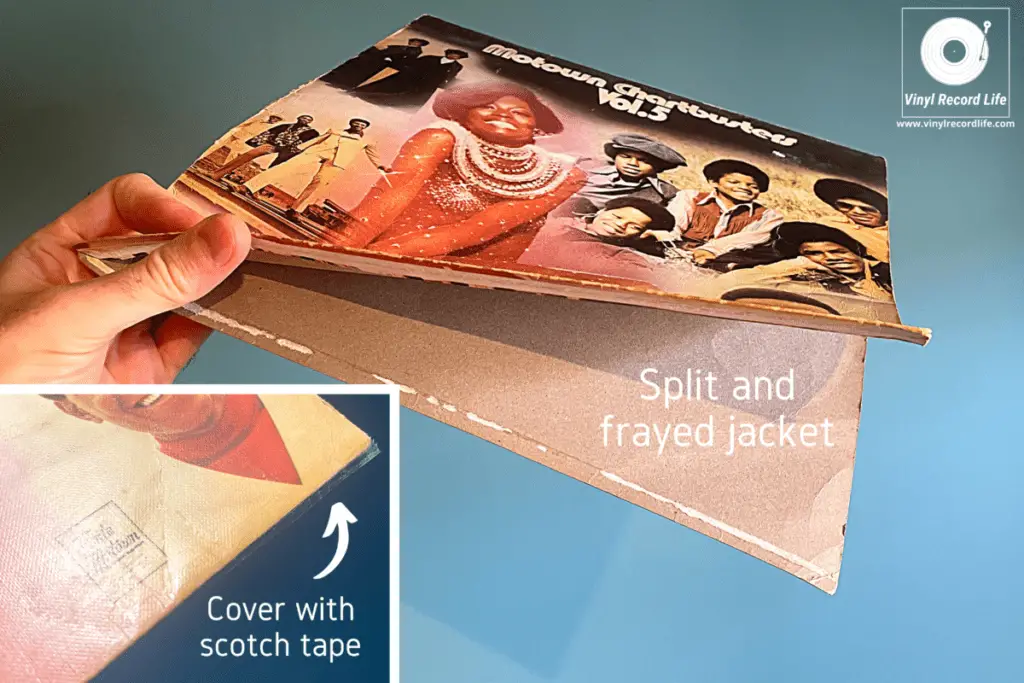
A record jacket is an important layer of protection for your record, so it’s important to make sure it’s always well sealed around the three edges that are supposed to be closed.
Another easy and quick step towards protecting record jackets is to buy a pack of new outer sleeves, like these ones, that will protect not only the record cover but which will also provide an extra layer of protection for the record inside.
